Posting Frequency Compared: Instagram vs TikTok vs YouTube in 2025
Posting Frequency Compared: Instagram vs TikTok vs YouTube in 2025
Your social media strategy in 2025 feels less like marketing and more like a high-speed treadmill. You're constantly running to keep up with posting schedules, algorithm changes, and engagement metrics. The question that keeps you up at night: how often is enough?
Should you post daily? Weekly? Multiple times per day?
The answer isn't simple because it changes for every platform. Instagram, TikTok, and YouTube are three huge platforms you should consider for your business. But each one operates by its own set of rules and algorithms, making it difficult to know exactly how often you should post.
In this blog post, we'll break down the ideal posting frequency for each platform based on data and research. We'll show you how to find a sustainable rhythm that drives growth without burning out your team. And we'll help you measure whether your strategy actually works.
The Impossible Standard
Many businesses feel like they have to post multiple times a day on every platform just to stay relevant. That constant pressure is one of the biggest causes of burnout. TikTok, for example, often encourages creators to share one to four posts a day, which is unrealistic for small teams.
When you're already managing operations, customer service, sales, and marketing, trying to keep up with that pace quickly becomes impossible. The sheer volume of content expected simply doesn't match the limited time and resources most businesses have. You end up sacrificing quality for quantity, which ultimately hurts your performance.
What's worse is that the social media environment doesn't make things easier. One expert might say posting three times a week is enough, while another insists it should be daily. The conflicting advice leaves you second-guessing every decision you make.
For instance, Neil Patel shared a TikTok back in 2024 where he mentioned the ideal posting frequency for each platform based on analysis he made of 332,490 social media accounts in 30 days. Here's what he concluded:
Posting On Instagram:
- Instagram Post/Reels - 1 to 2 times a day
- Instagram Stories - 2 to 4 a day
- Going Live on Instagram at least once a week
Note: if you post more than 2 times a day on Instagram, he concluded it affected the previous posts negatively.
Posting On TikTok:
- For TikTok it's good to post 1 to 3 times a day, worst case you need to post at least every other day, and if you don't, you'll find that it will take too long to build up momentum and your future.
Posting On YouTube:
- Post 1 short a day
- Post 1 long-form video a day
You should ideally spread them apart for at least 5 hours, and by posting a combo of both your content will grow faster. However, if you post too frequently on YouTube and the quality of the content isn't up to par, you'll find that all your videos won't perform as well as they should.
What Can You Take Away From This?
With advice changing from one source to another, it's easy to lose direction. Many brands end up second-guessing their approach or posting inconsistently because they're unsure what actually works. When you rush to push out content just to meet a number, quality takes a hit.
Low-quality posts can damage your credibility over time. Your audience notices when you're phoning it in, and they'll stop engaging with your content. That's when your reach starts to decline.
Also, every business has limits on time, budget, and team capacity. Without a clear posting plan, those resources disappear quickly. You need a strategy that balances growth with sustainability, not one that leaves your team exhausted after three weeks.
The best approach is to focus on a posting frequency that fits both your audience and your goals and that you can actually maintain.
How Often Should You Post On Instagram?
If you want to see consistent growth on Instagram, posting between three to five times per week is the sweet spot. That frequency gives you a solid balance between visibility and sustainability without burning yourself out or compromising content quality. You stay relevant in your followers' feeds without overwhelming them.
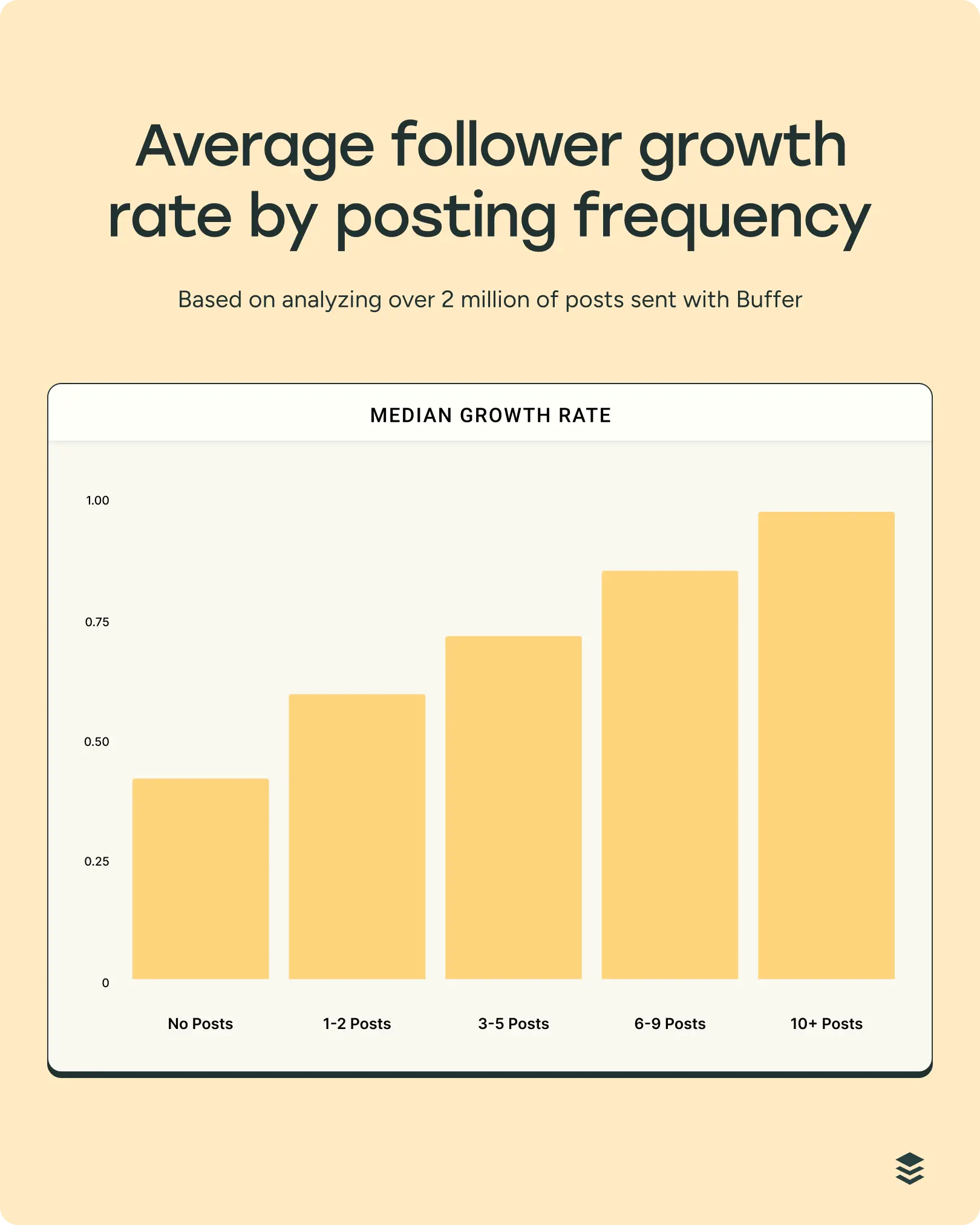
According to research by Buffer, posting more often generally leads to better results. After analyzing over two million posts from 100,000 Instagram accounts, they found that accounts posting three to five times a week more than doubled their follower growth rate compared to those posting less frequently. Going even further, accounts that post six to nine times weekly (or more) tend to see an even stronger growth rate.
If you think about it, that makes complete sense. The more often you post, the more chances your content has to appear in home feeds, Reels, and the Explore page. Each post is another opportunity for discovery and engagement.
Buffer's data also shows that accounts posting three to five times per week see an average 12% reach boost per post, while posting 10 times per week can raise that number to 24%. Those numbers are hard to ignore when you're trying to expand your audience.
However, quantity isn't everything. Posting more often can help you grow, but it's only effective if you can maintain quality and consistency. If increasing your frequency leads to rushed, low-value content, then it could actually harm your performance.
Relevance and value should always come first. Your audience follows you for specific content that helps or entertains them. When you start posting just to hit a number, they'll notice and disengage.
The best strategy is to find a rhythm that fits your goals and resources. For most brands, Buffer recommends this:
- 1-2 posts per week to stay active.
- 3-5 posts per week to grow sustainably.
- 6-9+ posts per week to maximize growth (if you can maintain quality).
In short, post as often as you can without sacrificing quality. That's the formula for consistent, long-term growth.
How Often Should You Post On TikTok?
Posting consistently on TikTok is one of the strongest ways to boost visibility and grow your audience. The platform rewards regular activity, and businesses that stick to it see clear results. According to Statista, personal accounts that post consistently average around 32,108 views per video. In comparison, business accounts generated on average 23,782 video views in the examined period.

Consistency also affects how your videos perform in the algorithm. Regular posters enjoy 2.5 times higher average view duration and 78% better audience retention. They also have better odds of landing on the For You Page, which is where real growth happens.
Plus, reliable posting helps followers know when to expect new content. They start checking your profile regularly because they know you'll have something new. That kind of anticipation builds loyalty and engagement over time.
Another important thing to consider is timing. The algorithm quickly evaluates videos within the first few hours, pushing content that gains fast engagement. Staying active gives the algorithm more chances to promote your videos and test different content approaches.
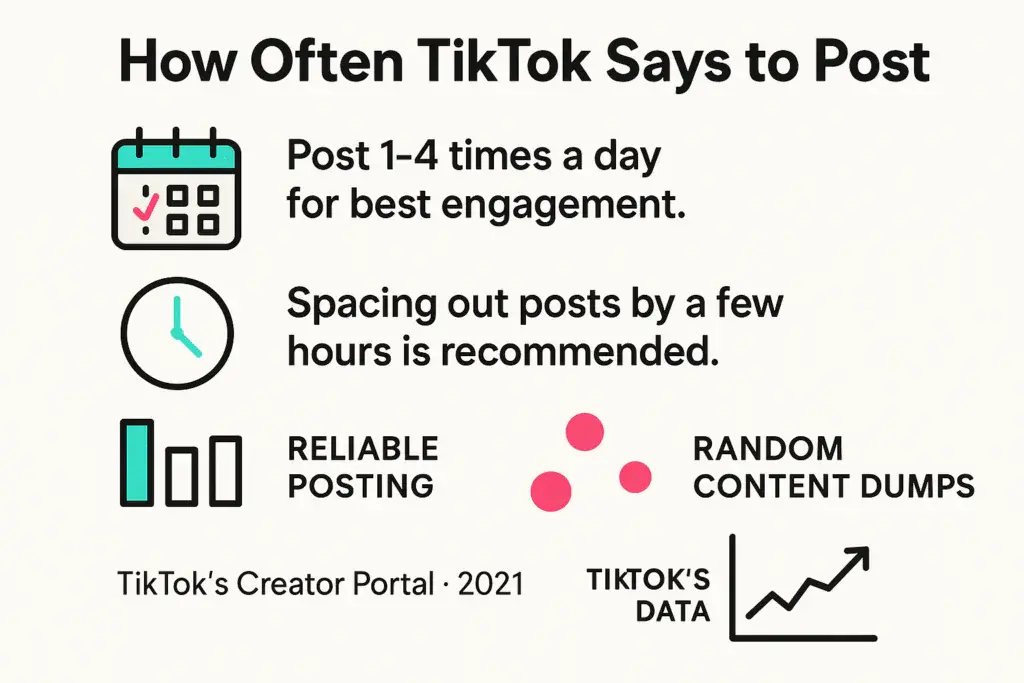
While TikTok officially recommends posting 1 to 4 times a day, most brands take a more sustainable approach. According to Recurpost, typical businesses post about 1.9 videos a week, while the top 25% of active brands share around four videos weekly. The difference shows how brands balance visibility with what's realistic for their teams.
For most businesses, a steady posting rhythm works best. Here's how it breaks down:
- Maintenance mode: 1-3 posts per week. Ideal for established brands focused on nurturing their audience.
- Steady growth: 3-5 posts per week. Best for most businesses that want consistent visibility and engagement.
- Aggressive growth: 1-2 posts per day. Perfect for new accounts or competitive markets that want to gain rapid reach.
In short, if your goal is consistent growth, posting three to five times a week is the best option.
How Often Should You Post On YouTube?
VidIQ analyzed data from over 5 million YouTube channels between June 2024 and June 2025 and found a clear pattern: channels that post more often grow faster. The data doesn't lie, and frequency matters on YouTube just as much as it does on other platforms.
Creators who upload 12 or more times per month get 53% more views and 66% more subscribers than those posting only 1 to 3 times a month. Every increase in posting frequency leads to faster growth in both views and subscribers. The compound effect is real.
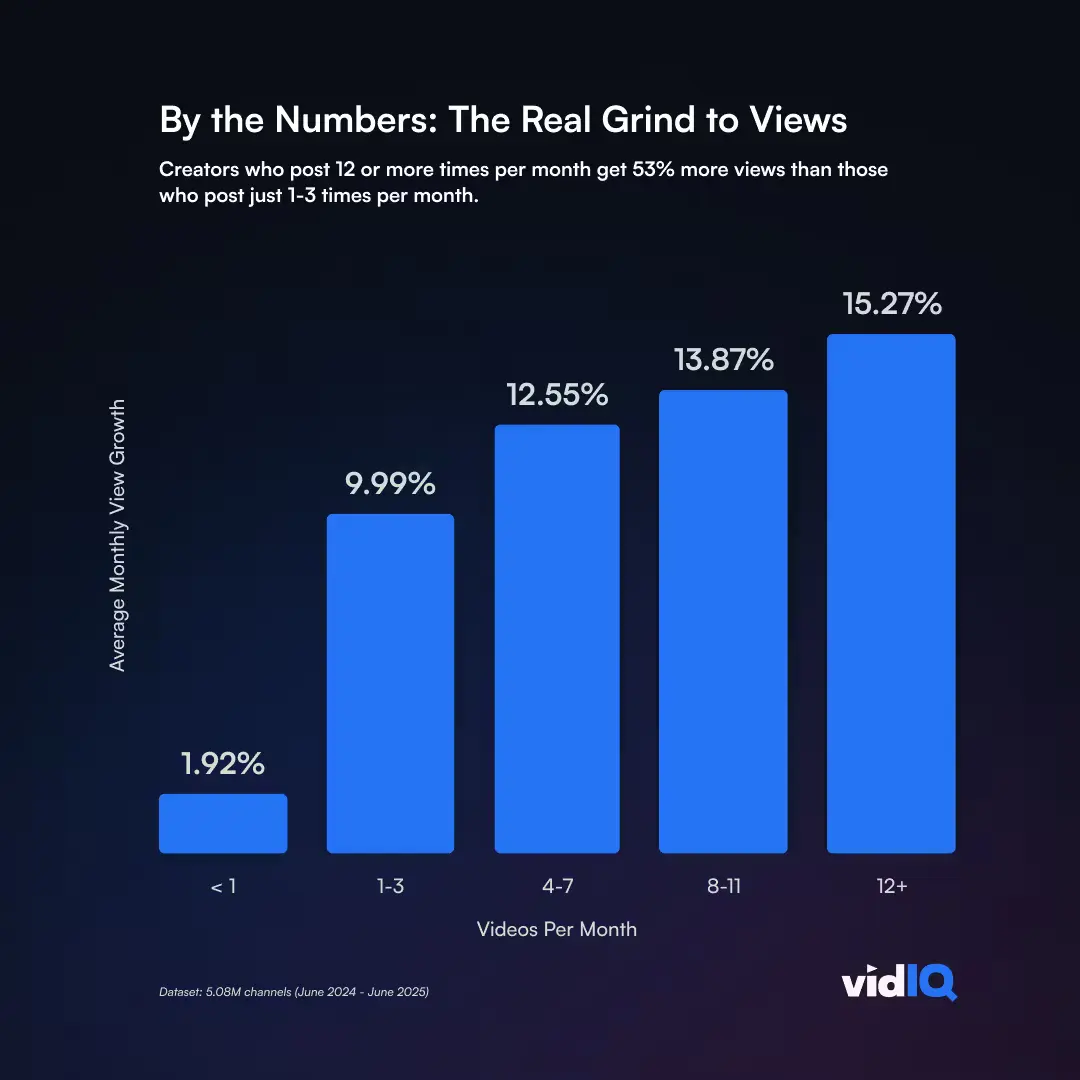
If you want consistent results, your goal should be to post more than once a week. The best growth happens when you reach around three uploads per week, or about 12 per month. At that rate, channels grow their views nearly eight times faster and gain subscribers more than three times faster than those posting less than once a month.
Uploading more frequently also helps you learn faster. You'll see what kind of videos perform best, which topics your audience enjoys, and where you can improve. The feedback loop accelerates your progress and helps you refine your content strategy based on real data.
That knowledge compounds over time. The more you post, the better you understand your audience and what resonates with them. That understanding translates directly into better performance.
That said, posting three times a week can be challenging. It requires planning, time, and an efficient system to manage production and avoid burnout. The effort pays off, but you need to be realistic if your team is small or your resources are limited.
It's important to align your upload schedule with your goals and capacity so you can stay consistent without sacrificing quality. Burning out your team for short-term gains isn't a winning strategy.
How To Know If Your Strategy Is Working
The metrics you track should align with your social media goals. Before creating content, identify what success looks like for your business. Are you trying to grow your audience? Improve customer satisfaction? Drive sales? Your metrics should reflect those priorities.
Audience Growth Metrics
Audience growth metrics are key performance indicators that show how your audience is expanding over a specific period. They give you a clear picture of how effective your growth strategies are and how well your content connects with people. These metrics help you understand engagement patterns, compare your performance to competitors, and measure brand awareness and account health.
To evaluate audience growth, start by tracking follower growth. This metric measures the net new followers you've gained within a specific time frame. It helps you see how your content, campaigns, and social media experiments are resonating with your target audience.
You can also look at follower growth rate, which shows how quickly you're gaining or losing followers. This helps you estimate whether your audience is expanding or shrinking and gives you insights into the effectiveness of your recent efforts. A declining growth rate signals that something needs to change in your strategy.
Finally, monitor your total audience size. It's a key indicator of your channel's health and long-term performance, showing whether your strategy is building a sustainable and engaged community over time.
Metrics To Monitor Customer Satisfaction
Customer satisfaction metrics help you understand how happy your audience is with your brand, products, or services. They reveal what's working, what needs improvement, and how you can strengthen customer relationships. These metrics focus on how people interact with your brand and how effectively you respond to them.
One key metric to track is reply time. The faster you respond to comments, messages, or mentions, the more valued your customers feel. When people don't get timely replies, they can feel ignored, which often leads to frustration.
All of this can escalate into spam, negative comments, or even hate comments that hurt your brand's reputation and credibility. Poor response times damage trust and make customers question whether you care about their concerns.
That's where tools like Spikerz can make a real difference. Spikerz offers comment moderation capabilities that help brands stay in control of their social media engagement. It automatically detects and filters out spam, bots, and even phishing links.
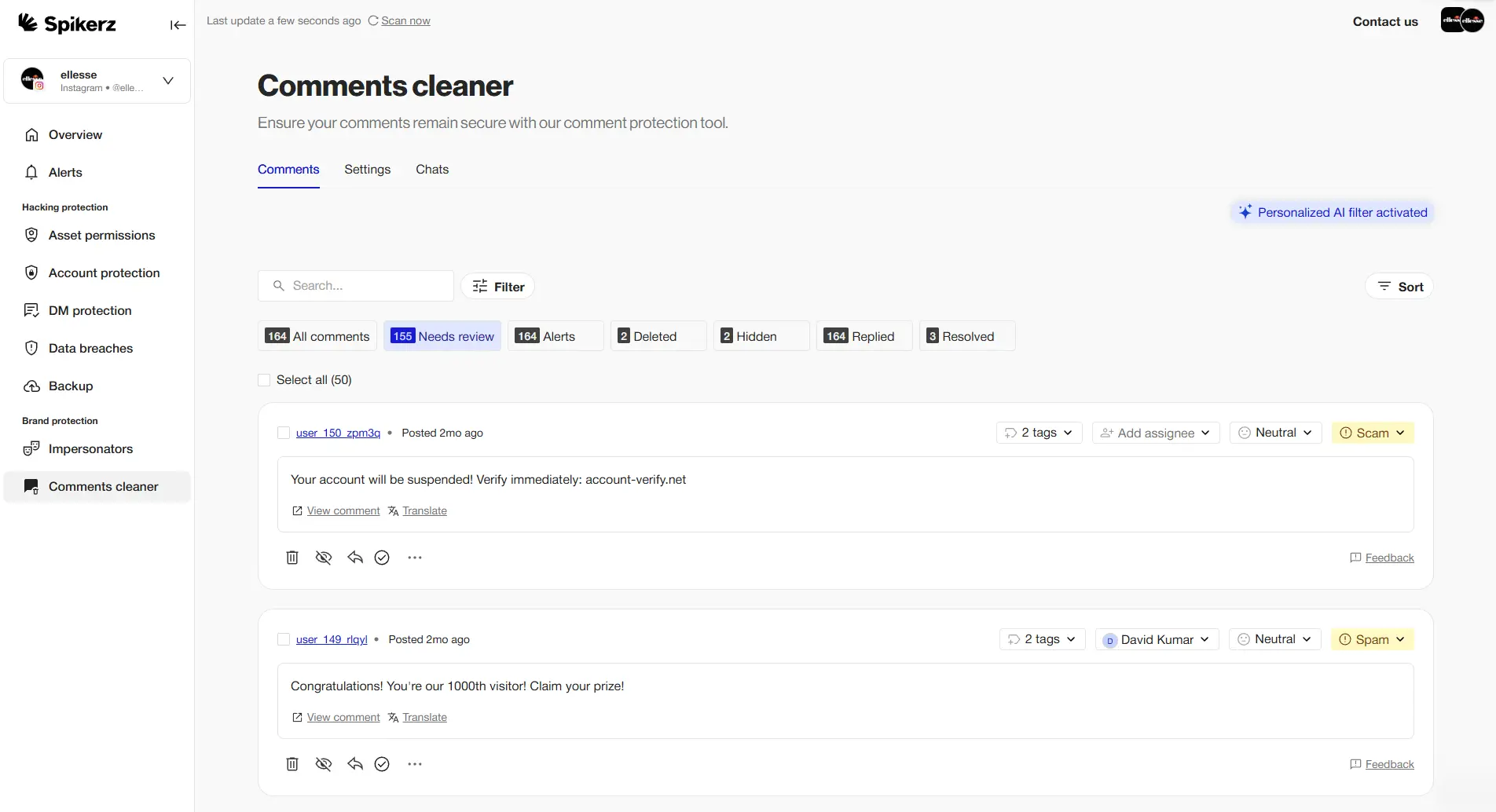
In addition to moderation, Spikerz tracks engagement risk, alerting users to threats like hate speech and bot-driven engagement hijacking. When you identify and remove these risks early, it protects your brand's image and ensures a safer, more authentic environment for your community.
So, if your team is feeling overwhelmed by the number of comments you receive and don't know which ones to prioritize, give Spikerz a try. It'll help remove all the spam so you can focus on what truly matters.
Once your moderation process is under control, you can focus on analyzing engagement quality. Monitoring comments is a valuable way to understand how customers perceive your brand and their experiences. Reviewing feedback regularly (both positive and negative) helps you identify trends and opportunities for improvement.
Another useful metric is total response volume, which measures how many replies your team sends to customers. A higher volume usually means you're being proactive in engaging with your audience and providing better customer care. It shows you're accessible and responsive.
Lastly, tracking your CSAT score gives you a clear view of how satisfied your customers are with your overall brand experience. It's a straightforward metric that helps you estimate if your social media efforts are meeting expectations and driving customer satisfaction.
Awareness Metrics
Awareness metrics measure how familiar and recognizable your brand is to your target audience. They help you understand whether your social media efforts are actually making your brand more visible and memorable. Evaluating these metrics gives you a clear sense of how well your content builds awareness and connects with potential customers.
The key awareness metrics you should monitor are reach and impressions. Reach tells you how many unique people saw your post, giving you an idea of how far your content is spreading. Impressions show how many times your post appeared on someone's screen, even if it was seen multiple times by the same person.
In other words, if one person sees your post three times, that's one reach but three impressions. Tracking both gives you a balanced view of how often people interact with your brand and how wide your visibility goes. High impressions with low reach might mean you're reaching the same people repeatedly.
Video views are another important awareness metric, especially on platforms like Instagram, TikTok, and YouTube. They help you see how effectively your content captures attention. When combined with data like view duration, engagement, or shares, video views reveal how well your content connects with audiences and encourages them to keep watching or interact further.
Metrics For Customer Retention
Customer retention metrics are key performance indicators that show how well a business keeps its existing customers over time. In social media marketing, these metrics help brands understand how loyal their audience is and how effective their online strategies are at driving repeat engagement and sales. Retention is often more valuable than acquisition because loyal customers spend more.
A good starting point is the Net Promoter Score (NPS), which measures how likely your customers are to recommend your brand to others. You can collect this data with quick surveys that ask customers to rate their likelihood of referring your brand on a scale from 0 to 10.
Those who choose 9 or 10 are considered promoters, while those who pick 0 to 6 are detractors. To find your NPS, subtract the percentage of detractors from the percentage of promoters to get a clear sense of overall satisfaction and loyalty. A positive NPS indicates strong brand health.

Social commerce platforms like Instagram Shopping, TikTok Shop, and YouTube Shopping give you a clear view of how often customers return to engage or make repeat purchases. Instagram's Commerce Manager provides insights like returning visitors, returning buyers, and sales generated from followers.
TikTok Shop offers similar analytics so you see how well your content drives loyalty and repeat sales. YouTube Shopping, integrated with product tagging and live shopping features, lets you see how your video content influences ongoing customer engagement and conversions.
Reviews are another strong indicator of customer loyalty. Monitor reviews and comments from Instagram, TikTok, and YouTube that customers leave to give you an idea of how satisfied your customers are with your brand. Monitoring and responding to these reviews, both positive and negative, not only improves your reputation but also strengthens relationships with your audience.
That said, when managing customer interactions (responding reviews, etc.), it's important to ensure that only approved team members have access to your accounts to avoid mistakes or unauthorized activity that could be damaging to your brand. One wrong response can turn a minor issue into a PR crisis.
In this case, you could use a tool like Spikerz (we've already mentioned it above). It offers robust permission management capabilities. You can assign role-based access levels to control who interacts with your customers, and monitor team activity to track what actions members are taking across the platform.
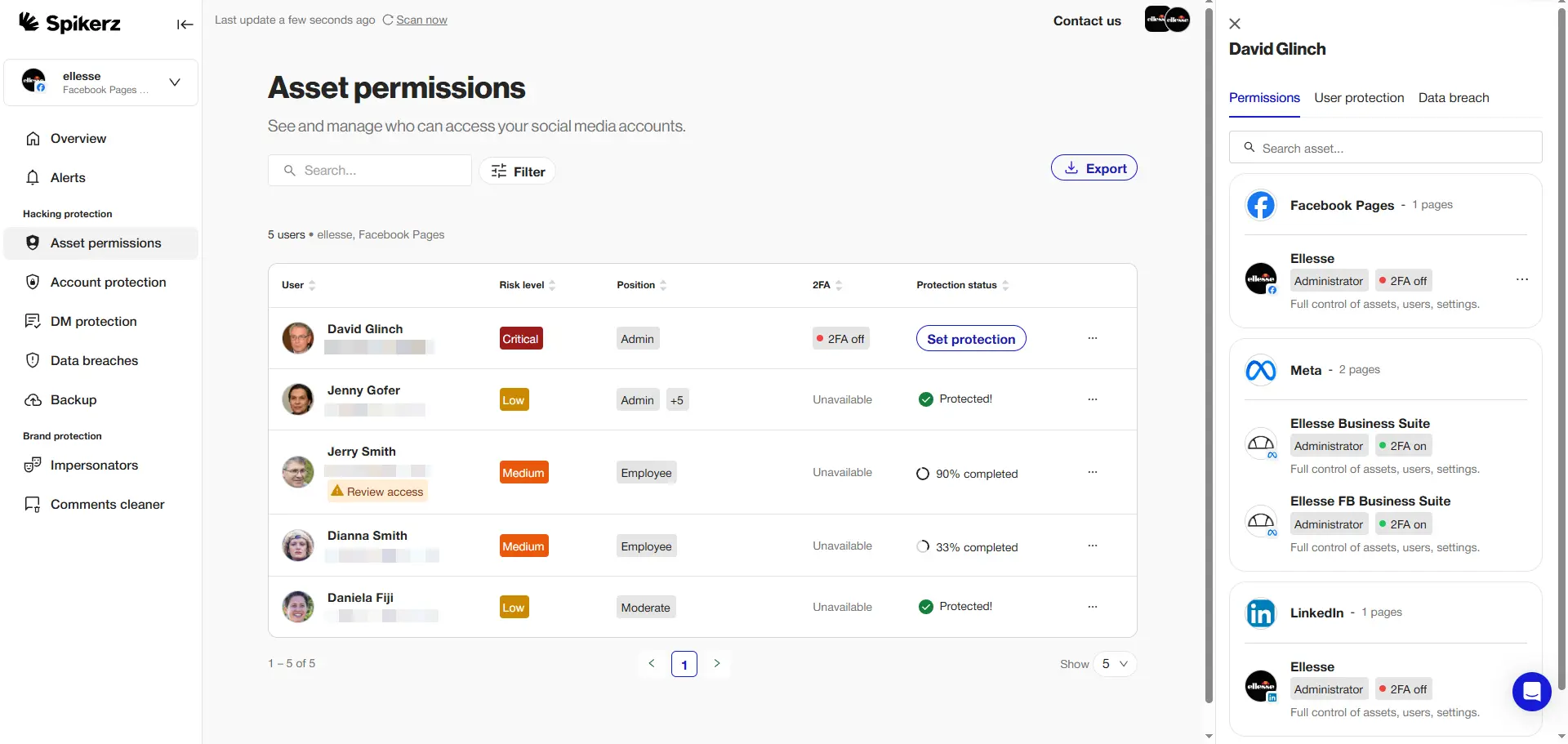
It helps you see every account linked to your brand (Instagram, TikTok, YouTube, Facebook, etc) and who has access to each one, reducing the risks that come with poor access management.
Metrics For Social Media ROI
Metrics for social media ROI help you understand how effective your social media efforts really are. They compare the return you're getting to the investment you've made, showing how your social activity contributes to your overall business results. Without these metrics, you're essentially flying blind.
One of the most important metrics to track is conversion rate. It measures how well your social ads or campaigns get people to take action, like making a purchase, subscribing, or visiting your website. To calculate it, divide total conversions by clicks, visits, or impressions, then multiply by 100.
%20Formula.webp)
You should also track social conversions, which happen when someone visits your site from social media and completes an action. For example, if a user clicks a link in your Instagram bio and buys a product on your site, that counts as a social conversion. These conversions directly tie your social efforts to revenue.
Another key metric is referral traffic, which measures how many visitors come to your website directly from social media posts or profiles. The best way to track this is with UTM codes, which let you see in Google Analytics how much traffic each specific post, campaign, or ad is generating.
Lastly, website traffic is an important indicator of how social media impacts your broader marketing efforts. If you notice more visits to your site after running an Instagram campaign, posting a YouTube video, or experimenting with TikTok content gives you a clear view of your social media ROI and helps guide best marketing decisions.
Brand Health Metrics
Brand health metrics measure how your brand performs, how it's perceived, and where it stands in the market. They help you track awareness, sentiment, and competitiveness. Strong brand health translates to customer loyalty, premium pricing power, and competitive advantages.
One of the most telling metrics is audience sentiment. It goes beyond what people say and focuses on how they feel about your brand and products. Social listening tools make this measurable by turning real-time conversations into data you can act on.
Brand mentions are another key metric. They track how often your brand appears in posts or comments, whether people tag you or not. A steady rise in organic mentions signals stronger brand awareness and engagement.
Social listening also helps identify common keywords or themes that appear alongside your brand name, showing whether mentions praise you, provide feedback, or criticize you. Understanding sentiment helps you respond appropriately and protect your reputation.
Share of voice gives you a competitive benchmark. It measures how much of the social conversation in your industry is about your brand compared to others. It gives you a clear sense of your position in the market and helps you understand where you stand against competitors.
Social Media Engagement Metrics
Social media engagement metrics are measurable data points that show how users interact with your content, like comments, shares, likes, etc. They help you understand how active and responsive your audience is and reveal which types of posts capture the most attention. High engagement signals that your content resonates.
One of the key metrics to look at is post engagement rate. It tells you how actively your audience interacts with your content. A high engagement rate usually means your posts are effective and your approach is working. Calculate it by dividing total engagements by total followers or reach.
Likes, comments, and interactions are small signals, but when you track them together, they reveal a lot. Over time, the interactions show what your audience values and what kinds of content spark the most responses. Patterns emerge that guide your content strategy.
Shares provide another layer of insight because they show which posts your audience finds valuable enough to send to others, expanding both your reach and credibility. Shares are essentially free amplification from people who trust your content enough to put their reputation behind it.
If you're creating video content for Instagram, TikTok or YouTube, video completion rate is another essential metric. It shows how many people stayed to watch until the end, which indicates that your video is compelling from start to finish. High completion rates signal that your content delivers value throughout.
Paid Social Media Metrics
Paid social media metrics are the data points that help you understand how well your ads are performing. They show whether your ads are attracting attention, driving engagement, and generating revenue. Evaluating these types of metrics helps you decide which campaigns to scale and which to improve or shut down.
%20Formula.webp)
Click-Through Rate (CTR) is one of the most common metrics to look at. It measures how often people click your content compared to how many times it's seen. You can track it across platforms, PPC campaigns, call-to-action buttons, and landing pages.
Since CTR varies by content type, industry, and platform, it's best to compare it with your own past performance. Benchmarking against yourself gives you the most accurate picture of improvement or decline.
%20Formula.webp)
Cost Per Click (CPC) is another key metric that shows how much you pay for every click on a paid post or ad. Cost Per Impression (CPM) shows how much you spend per thousand views. Both metrics help you assess how efficiently your budget is being used to reach and engage your audience.

Next, track web conversions. They show what happens after someone clicks your ad, for example, making a purchase, signing up for an event, or reading an article. They tell you whether your ad is driving meaningful actions that align with your business goals and justify your ad spend.
%20Formula.webp)
Finally, Return on Ad Spend (ROAS) reveals how much revenue your campaigns generate for every dollar spent. It's a more detailed way to measure ad ROI and helps you identify which campaigns deliver the most value. High ROAS campaigns deserve more budget, while low ROAS campaigns need optimization or elimination.
Conclusion
The pressure to post constantly across every platform has created an impossible standard that leads to burnout and poor content. But the solution isn't working harder; it's working smarter by focusing on sustainable posting frequencies that actually drive results.
For Instagram, aim for three to five posts per week to balance visibility with quality. On TikTok, the same three to five weekly posts will keep you competitive without overwhelming your team. YouTube demands more production time, so three uploads per week (about 12 per month) delivers the strongest growth when you can maintain it. These frequencies aren't arbitrary; they're backed by data from millions of accounts and channels that have found the sweet spot between consistency and sustainability.
The metrics that matter most depend on your specific goals. Track audience growth if you're building reach. Monitor customer satisfaction if retention is your priority. Measure ROI if revenue drives your decisions. Whatever your focus, remember that posting frequency is just one variable in a complex equation that includes content quality, audience understanding, and strategic consistency. Start with a frequency you can maintain, measure what matters, and adjust based on real performance data rather than the latest expert opinion.

.webp)

